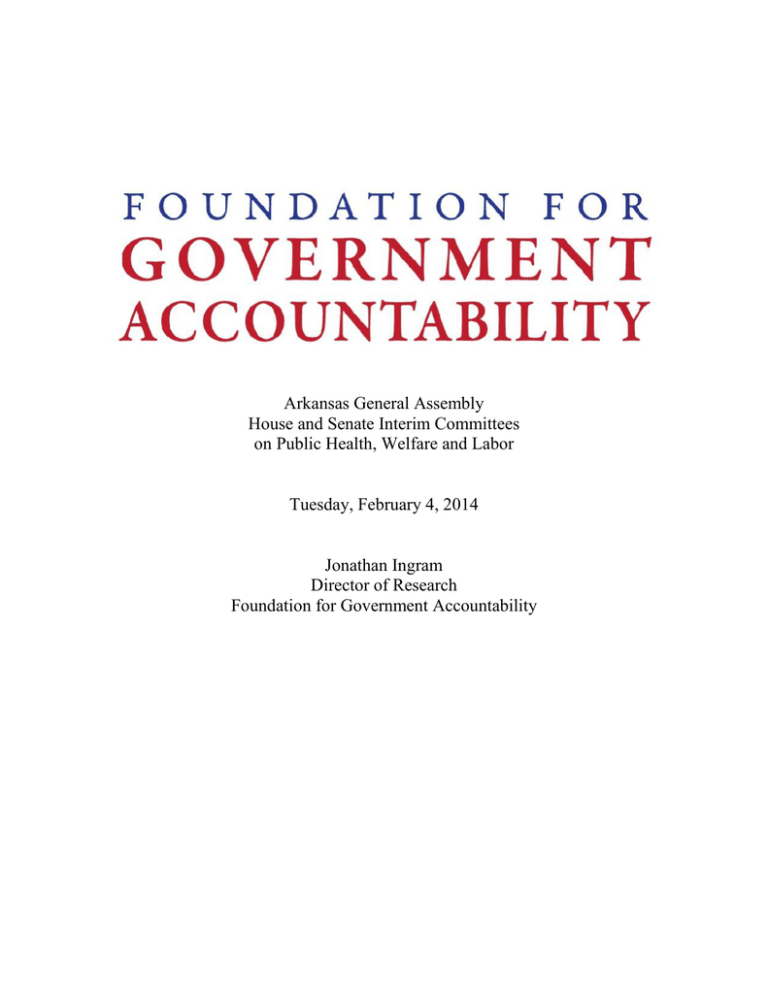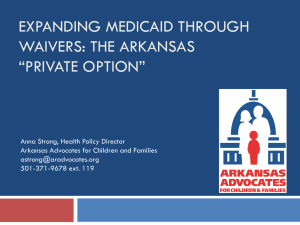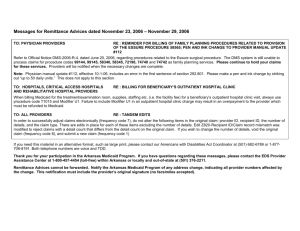Arkansas General Assembly House and Senate Interim Committees
advertisement

Arkansas General Assembly House and Senate Interim Committees on Public Health, Welfare and Labor Tuesday, February 4, 2014 Jonathan Ingram Director of Research Foundation for Government Accountability Chairman Burris, Chairperson Bledsoe and Members of the Committee, thank you for the opportunity to speak today. My name is Jonathan Ingram. I am an attorney and serve as director of research at the Foundation for Government Accountability. We are a non-partisan research organization focused exclusively on health and welfare issues and we work with legislators and executive branch officials across the country to improve failing Medicaid programs. You can learn more about our work at MedicaidCure.org. As this Committee well knows, there is an open question of whether the special terms and conditions of Arkansas’s Private Option waiver conflict with the Act’s requirements that it be terminated upon appropriate notice.1 The Act restricted the Department of Human Services to only seek waivers and state plan amendments that comply with the authorizing legislation, including the termination plans.2 Some language in the waiver’s special terms and conditions indicate that phasing out the program, letting it expire or amending the waiver could take longer than the 120 days envisioned by the Legislature.3 Simply amending the state plan, as the Department of Human Services previously suggested, also comes with its own timeline and approval process. Each of these options require federal approval and it is unclear whether the state would be able to make those changes apply retroactively to a date prior to final approval, because this is a change to eligibility and not to something such as payment rates or covered services. This issue, while complicated, is extremely important for several reasons. The largest reason is that it is entirely possible that federal financial support for the Private Option will fall below 100 percent during the next three years. The special terms and conditions agreed to by the Beebe administration features a monthly per-person cap on federal support.4 The state is responsible for all costs which exceed that cap. But the statute authorizing the Private Option contains contingencies in case federal support falls below promised levels.5 Indeed, costs so far appear to be above the state’s initial projections. Based on the latest audit report, actual per-person costs have exceeded projections by about $4.40 per person, per month. 67 Although the state built a little wiggle room into the cap it negotiated with the federal government, Arkansas is already dangerously close to that cap.8 Given the inherent unpredictability in the Private Option’s design, there is a very real possibility that you will exceed this cap in the coming months and years. Exceeding that per-person cap by just a few dollars can result in the state having to repay the federal government tens of millions of dollars in Medicaid funds. More problematic, however, is that the cap will only grow by 4.7 percent annually.9 The state, in its waiver request, predicted costs to rise by roughly 5 percent per year. 10 Last spring, when Optimus projected costs for the Private Option, it predicted costs would increase by roughly 6.5 percent annually.11 Not only do you face the very real possibility of exceeding the initial cap, but if the costs grow even a few percentage points faster than the waiver allows, the state is looking at potentially repaying the federal government hundreds of millions of dollars. Scenario Costs exceed monthly cap by $1 Costs exceed monthly cap by $5 Costs grow at 5 percent Costs grow at 7 percent Costs exceed monthly cap by $1 and grow at 7 percent Costs exceed monthly cap by $5 and grow at 7 percent Potential 2014-2016 cost overruns $7 million to $9 million $36 million to $46 million $11 million to $14 million $82 million to $106 million $90 million to $116 million $121 million to $155 million The design of the program makes these kinds of cost overruns highly likely. Unlike Medicaid managed care reforms, for example, the state does not set multi-year contracts through competitive bidding under the Private Option. Instead, the state pays premiums and additional subsidies to cover deductibles, coinsurance, copayments and other out-of-pocket costs. The state simply has no real negotiating leverage with the plans and no predictability of future premium increases. The fact that enrollees can pick any Silver plan at no cost creates even more unpredictability. In some regions, the difference between the lowest-cost plan and the most expensive plan is nearly 90 percent.12 In Fayetteville, for example, the least-expensive Silver plan available to a 37-yearold costs roughly $3,200 per year in premiums. 13 But the most expensive plan costs more than $6,000 per year in premiums.14 Private Option enrollees have no incentive to pick those lowercost options. Lowest and highest annual Silver plan premium for 37-year-old, by rating area Statewide average $3,281 Rating Area 1 $3,414 Rating Area 2 $3,170 Rating Area 3 $3,206 Rating Area 4 $3,150 Rating Area 5 $3,588 $3,381 Rating Area 6 $3,623 $3,414 Rating Area 7 $3,055 Highest-cost Lowest-cost $5,117 $5,217 $5,492 $6,070 $4,993 $5,444 The federal exchange sought to discourage this kind of behavior by pegging federal subsidies to the second-cheapest plan.15 If individuals want a more expensive plan, they must pay the difference. But despite the fact that the Act provides that individuals in the Private Option have the same kind of cost sharing requirements that those in the exchanges have, Private Option enrollees can pick any plan at no cost.16-17 Difference in out-of-pocket costs between Private Option enrollees and exchange enrollees, by plan choice, for a 37-year-old non-smoker at or near 138 percent FPL Total out-ofpocket costs, Annual Plan type and program Deductible excluding premiums premiums All Private Option plans $0 $604 $0 Lowest cost Arkansas exchange plan $150 $754 $385 Benchmark Arkansas exchange plan $150 $754 $522 Most expensive Arkansas exchange plan $150 $754 $2,237 Louisiana exchange plans $150 - $500 $700 - $2,150 $445 - $1,266 While these individuals were supposed to have the same amount of cost sharing, those in the Private Option can expect to pay hundreds or even thousands of dollars less than similarlysituated populations in the exchange. And, of course, those below the federal poverty level will pay absolutely nothing under the Private Option, at least under its current terms. There are other issues where the waiver seems to differ from legislative intent, at least as expressed during committee, in town halls, to constituents and in the legislative chambers, though these are not necessarily in direct conflict with the express language of the statute. Thank you, again, for the opportunity to speak with you. I’d be happy to take any questions you may have. 1 See, e.g., presentations given by Conduit for Action and the Bureau of Legislative Research before the Joint Committees on Public Health, Welfare and Labor on January 16, 2014. 2 Health Care Independence Act of 2013, Arkansas Code § 20-77-2101 et seq. 3 Centers for Medicare and Medicaid Services, “Special terms and conditions: 11-W-00287/6,” U.S. Department of Health and Human Services (2013), http://www.medicaid.gov/Medicaid-CHIP-Program-Information/ByTopics/Waivers/1115/downloads/ar/ar-private-option-ca.pdf. 4 Ibid. 5 Health Care Independence Act of 2013, Arkansas Code § 20-77-2101 et seq. 6 The Division of Legislative Audit reports an average monthly cost of $476.59 per person as of January 2014. See, e.g., Division of Legislative Audit, “Special report: Arkansas Department of Human Services – Medicaid Private Option program,” Arkansas Legislative Joint Auditing Committee (2014), http://arklegaudit.gov/showfile.php?t=webaudit&fid=SASR50213. 7 In its waiver request, the state predicted an average monthly cost of $472.19 per person in 2014. See, e.g., Centers for Medicare and Medicaid Services, “Arkansas 1115 waiver application,” U.S. Department of Health and Human Services (2013), http://www.medicaid.gov/Medicaid-CHIP-Program-Information/ByTopics/Waivers/1115/downloads/ar/ar-private-option-ar.pdf. 8 The federal government has capped its financial participation at an average monthly cost of $477.63 per person in 2014. See, e.g., Centers for Medicare and Medicaid Services, “Special terms and conditions: 11-W-00287/6,” U.S. Department of Health and Human Services (2013), http://www.medicaid.gov/Medicaid-CHIP-ProgramInformation/By-Topics/Waivers/1115/downloads/ar/ar-private-option-ca.pdf. 9 Ibid. 10 Centers for Medicare and Medicaid Services, “Arkansas 1115 waiver application,” U.S. Department of Health and Human Services (2013), http://www.medicaid.gov/Medicaid-CHIP-Program-Information/ByTopics/Waivers/1115/downloads/ar/ar-private-option-ar.pdf. 11 Optimus, “March 27 estimates,” Arkansas Department of Human Services (2013), http://humanservices.arkansas.gov/director/Documents/March%2027%20Estimates.pdf. 12 Jonathan Ingram, “The empty promises of Arkansas’ Medicaid Private Option,” Foundation for Government Accountability (2014), http://uncoverobamacare.com/wp-content/uploads/2014/01/UO-The-Empty-Promises-ofArkansas-Medicaid-Private-Option.pdf. 13 Ibid. 14 Ibid. 15 26 U.S.C. § 36B (2011), http://www.gpo.gov/fdsys/pkg/USCODE-2011-title26/pdf/USCODE-2011-title26subtitleA-chap1-subchapA-partIV-subpartC-sec36B.pdf. 16 Health Care Independence Act of 2013, Arkansas Code § 20-77-2101 et seq. 17 Centers for Medicare and Medicaid Services, “Arkansas 1115 waiver application,” U.S. Department of Health and Human Services (2013), http://www.medicaid.gov/Medicaid-CHIP-Program-Information/ByTopics/Waivers/1115/downloads/ar/ar-private-option-ar.pdf.


